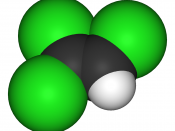Each week I purchase people magazine as a curiosity to get involve with the personal life of Hollywood celebrities. But this time the story that got my attention was very different from the one's that I usually read. Sheila Holt, who is battling breast cancer, is a victim of high-tech industries. She almost lost all of her close family through cancer, and now she is sharing her sad story with the editor of people magazine. "You can't imagine what it is like for anyone in my family to go in for a physical", she says. "You prepare yourself to be shocked and terrified." She is remembering her simple pleasure of growing up in the Tennessee countryside: the ice-cold water that flowed from the faucets of her family farm. "Every day I would fill up a jug," she says. "It had this wonderful, slightly sweet taste. I thought it was good for me" [1].
But decades later, she found out her habit was far from healthy. Her landfill's water was contaminated with trichloroethylene (TCE), an industrial solvent that can cause liver and kidney damage and is suspected of causing cancer. Later after reading that article I get interested to know more about this substance, so I started doing some online searching. The chemical compound trichloroethylene is a chlorinated hydrocarbon commonly used as an industrial solvent. It is a clear non-flammable liquid with a sweet smell. In industry, it is informally referred to by the abbreviations TCE. The chemical formula of Trichloroethylene is CICH=CCL2, with the molecular formula C2HCl3. The appearance is a colorless liquid, which has a melting point of 200 K and boiling point of 360 K. Its chemical structure is [2]:History:Trichloroethylene pioneered by Imperial Chemical Industries in Britain and it was used from 1930 as a volatile anesthetic...


